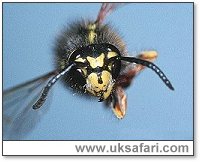
|

|
|
 Sent
to you Sent
to you
by e-mail
|
|
Simply
enter your details and hit the send button
more
info |
|


Click Here

Links
Advertise
Terms of Use
Contributors
About Us
Contact Us
|
 |
Go back
 | Bookmark
| Bookmark
 | Print Page
| Print Page  | E-Mail Us
| E-Mail Us 



Photo: G. Bradley |
|
UK
Safari Tip:
Find out more about wasps and other invertebrates with the fully
illustrated fold out chart called "Bugs on Bushes" - click
here
|
|
Latin name: Vespula vulgaris
Size: Around 2cms long.
Distribution: Found throughout the UK.
Months seen: April to late October
Habitat: Often found nesting in houses.
Food: Anything sweet or sugary like fruit or the saliva produced by wasp larvae.
Special features: Although there are several different species of social wasps in Britain, this is the one most frequently seen.
Common wasps live in a colony which can contain up to 2,000 other wasps. Each colony consists of:
Queen - who lays all the eggs
Larvae - The young wasps which hatch from the queen's eggs
Workers - who catch and kill the food for the larvae
Drones - whose main purpose is to mate with the queen.
 The
wasp nest is normally built underground, or sometimes under the eaves or in the attics of buildings. It is made from paper which the wasps create by chewing wood into a pulp. The
wasp nest is normally built underground, or sometimes under the eaves or in the attics of buildings. It is made from paper which the wasps create by chewing wood into a pulp.
In spring and early summer, the workers go out to sting caterpillars, flies and other insects which they bring back to the nest as food for the developing larvae. The larvae in turn produce a sweet saliva which the adults drink.
By the end of summer the wasp larvae will have transformed into adult males and queens. The queen stops laying eggs, and usually dies. Without larvae, the other wasps have no food, and so they leave the nest in search of alternatives, such as fruit and nectar.
 Once mated, the new queens fly off to find a place to hibernate through the winter. The following year each one that survives the winter will start a new colony. Once mated, the new queens fly off to find a place to hibernate through the winter. The following year each one that survives the winter will start a new colony.
|

UK Safari Creepy-Crawlies Section
|
 |

|